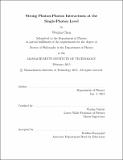| dc.contributor.advisor | Vladan Vuletić. | en_US |
| dc.contributor.author | Chen, Wenlan, Ph. D. Massachusetts Institute of Technology | en_US |
| dc.contributor.other | Massachusetts Institute of Technology. Department of Physics. | en_US |
| dc.date.accessioned | 2015-10-14T14:35:54Z | |
| dc.date.available | 2015-10-14T14:35:54Z | |
| dc.date.copyright | 2015 | en_US |
| dc.date.issued | 2015 | en_US |
| dc.identifier.uri | http://hdl.handle.net/1721.1/99256 | |
| dc.description | Thesis: Ph. D., Massachusetts Institute of Technology, Department of Physics, 2015. | en_US |
| dc.description | This electronic version was submitted by the student author. The certified thesis is available in the Institute Archives and Special Collections. | en_US |
| dc.description | Cataloged from student-submitted PDF version of thesis. | en_US |
| dc.description | Includes bibliographical references (pages 137-142). | en_US |
| dc.description.abstract | Engineering light at the single photon level is a long-standing goal in physics. In this thesis, we investigate optical nonlinearities at the single photon level orchestrated by an optical cavity. We demonstrate an all-optical transistor where one stored 'gate' photon controls the propagation of a 'source' light beam. The system is based on EIT and a highcooperativity cavity. Each 'gate' photon is converted to an EIT polariton and strongly suppresses the cavity transmission of subsequently applied source photons. One stored gate photon can be retrieved from the atomic ensemble after switching off more than one source photon. Without retrieval, one stored gate photon can switch up to several hundreds source photons. Next, instead of storing the photon, we let it propagate slowly and operate the system in the continuous mode. We observe an anti-cross-correlation between freespace and cavity beams. The cross-correlation function at zero time is g2 = 0:89 which means a photon in one beam extinguishes one photon in the other beam with a probability of 11%. It is a deterministic photon-photon interaction at the single photon level. Using similar skills, we propose a new method to measure zero or one photon fock states, without destroying the photons. We are improving the setup which is approaching the non-destructive measurement of photons. Potentially, this method will enable new applications in quantum information and computation. It will also enable the observation of different internal degrees of the photons, such as polarization or photon number, at the same time without losing the photons. By reducing the power to zero, we investigate the nonlinearity of the vacuum field in the optical cavity. By replacing the control beam in EIT by the vacuum field, we observe vacuum induced transparency (VIT). This effect indicates that vacuum field strongly distorts the dispersion of atoms in a way that cannot be explained by classical electromagnetism. In order to reach even stronger single-photon interaction regime, we need to enhance the cavity cooperativity to even higher parameters. At the end of this thesis, I describe our progress towards the micro cavity system. By using a micro cavity, we enhance the cooperativity by a factor of 20. This improvement will suppress decoherence and move forward research into single photon nonlinearities. | en_US |
| dc.description.statementofresponsibility | by Wenlan Chen. | en_US |
| dc.format.extent | 142 pages | en_US |
| dc.language.iso | eng | en_US |
| dc.publisher | Massachusetts Institute of Technology | en_US |
| dc.rights | M.I.T. theses are protected by copyright. They may be viewed from this source for any purpose, but reproduction or distribution in any format is prohibited without written permission. See provided URL for inquiries about permission. | en_US |
| dc.rights.uri | http://dspace.mit.edu/handle/1721.1/7582 | en_US |
| dc.subject | Physics. | en_US |
| dc.title | Strong proton-photon interactions at the single-photon level | en_US |
| dc.type | Thesis | en_US |
| dc.description.degree | Ph. D. | en_US |
| dc.contributor.department | Massachusetts Institute of Technology. Department of Physics | |
| dc.identifier.oclc | 923021933 | en_US |
